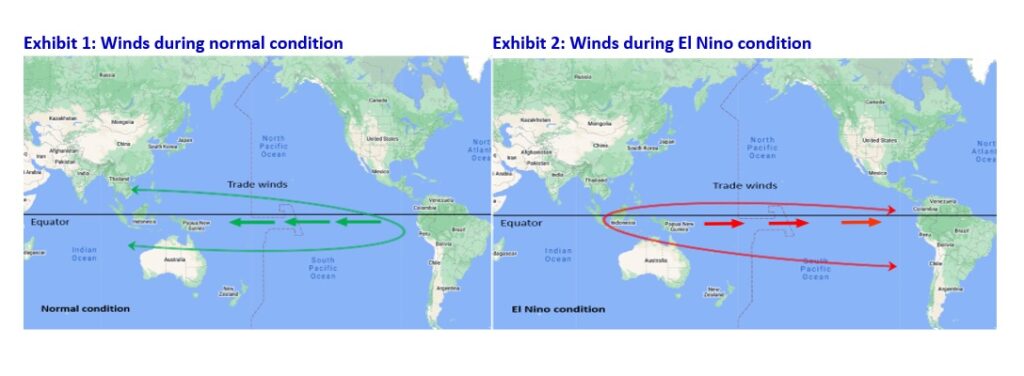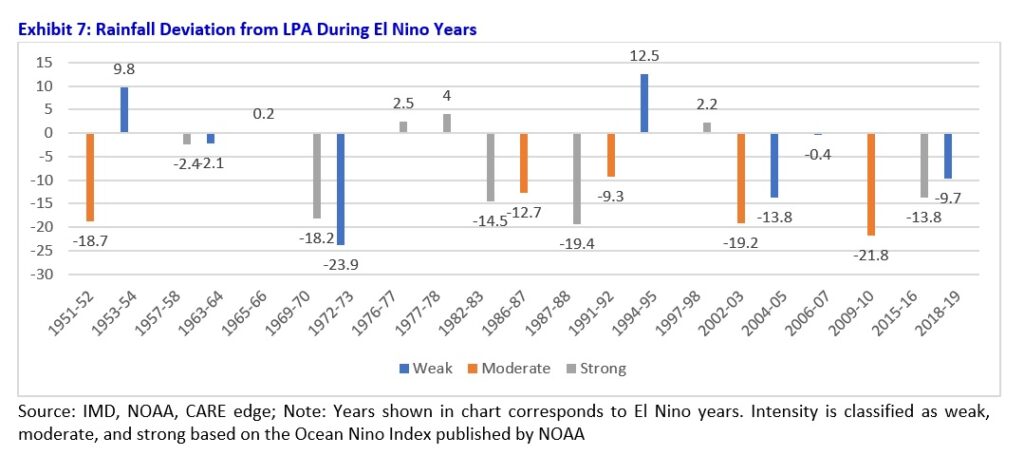What is El Nino?
El Nino is a climatic condition which results in warming of surface water in the equatorial Pacific Ocean suppressing monsoon rainfall in India. It impacts monsoons and consequently agricultural output, which in turn bears on inflation and economy.
Under normal conditions over Pacific Ocean, trade winds blow west along the equator, taking warm water from South America towards southeast Asia. This phenomenon brings monsoon to India between June to September. During El Nino periods, there is unusual warming of surface waters in the east tropical Pacific Ocean, and hence trade winds blow in the opposite direction. This phenomenon reduces rainfall in India and increases rainfall in South America. Depending upon its intensity El-Nino could cause below-normal monsoon or even draught in India and other southern eastern countries such as Indonesia and Australia.

High probability of El Nino this year
After 4 years of normal monsoon, India is staring at below-normal monsoon this year. In the case of India, the occurrence of El Nino is linked with the poor monsoon implying below normal or deficient rainfall during the June-September period.
As per the latest monthly update by National Oceanic and Atmospheric Administration (NOAA, a US based agency) issued in May 2023, there is 90% probability of occurrence of El Nino between June and August, and more than 90% probability of occurrence between July and September, which is the peak period of Indian monsoon. Arrival of El Nino after September is not expected to impact India’s monsoon.

Favourable effect of Indian Ocean Dipole can offset the impact of El-Nino to some extent
IOD refers to the difference in temperature between western pole of Arabian sea and eastern pole of eastern Indian ocean south of Indonesia.
Indian Meteorological Department (IMD) has predicted normal monsoon for the current year, and that positive Indian Ocean Dipole (IOD) could offset impact of El Nino and result in favourable monsoon. IOD is currently neutral, and index value for the week ending 20th June 2023 was 0.0°C, which is within neutral bounds (between -0.40°C and +0.40°C). As per Australian Bureau of Metrology, there is high probability of the IOD to increase above +1.2°C between July and September.


The impact of phenomenon on southwest monsoon
We have had 21 El Nino years and 15 draughts over the last 50 years in India. 10 of the 15 draughts where during the El Nino years. Historically during strong or moderate El Nino years, rainfall reduced up to 24% and average deviation in rainfall was around 15%.
Past data also show that during some El Nino years, rainfall was normal owing to favourable offsetting factors. For example, despite 1994, 1997 and 2006 being El Nino years, India received normal or even excess rainfall as IOD was positive. In 1969, 1976, and 1977, India received normal rainfall either because the intensity of El Nino was weak, or its arrival was towards the end of India’s monsoon season.



El Nino impact on Inflation during the last two decades
Over the last two decades there have been instances of spike in inflation traced to intensity of El-Nino in that or the previous year. For instance, during 2002-03, 2009-10 and during 2015-16 where El-Nino intensity was moderate or strong, WPI inflation during the subsequent year increased. Adequate stock of food grains maintained by FCI softened the impact on inflation in some of those years.

Possible Impact on Indian Economy in FY24
India is currently battling to tame inflation, rekindle rural demand, and maintain consumption growth, amidst adverse weather conditions (heat waves) and global slowdown. Currently, agriculture contributes 18% to India’s GVA (gross value add) and 47% of work force is employed under agriculture sector. More than 50% of net sowed land in India depends on monsoon rain, which also replenish water reservoirs, and hence bears heavily on farm production. Below-normal monsoon could impact farm production, commodity prices and dent rural demand, which could in turn spill over to sectors such as FMCGs, Automobiles (2W, 3W and tractor), cement, and agro chemicals.
Additionally, should Australia (key exporter of wheat) and Indonesia (key producer of rice and exporter of palm oil) be adversely impacted by El Nino, food prices in international markets could rise, also posing upside risk to inflation in India.
Over the years however, there has been diversification in rural economy away from agriculture. According to Niti Aayog report, 2/3rd of rural income is contributed by non-agricultural sectors such as manufacturing, construction, and services. Government’s spending on infrastructure also adds to non-farm income. These factors could offset the impact of El Nino on rural demography.
As per Food Corporation of India (FCI), wheat stock as of June 2023 was around 31.3 MMT (2022: 28.5 MMT) and rice was 26.2 MMT (2022: 31.7 MMT), well above buffer levels. This should help in case of shortage of rainfall and consequent lower-than-expected production. Government could also ban export of key food grains to curtail inflation
Conclusion
While El-Nino is likely, its impact hinges upon several factors such as its timing and intensity, and that of IOD during the next three months. Given the dependence of agricultural produce on monsoon, below-normal rains could pose upside threat to inflation and dampening of rural demand. This could partially be offset by diversification of rural income and Government’s steps to curb food prices.

Disclaimer:
The views provided in this blog are of the author and do not necessarily reflect the views of Vivriti. This article is intended for general information only and does not constitute any legal or other advice or suggestion. This article does not constitute an offer or an invitation to make an offer for any investment.


